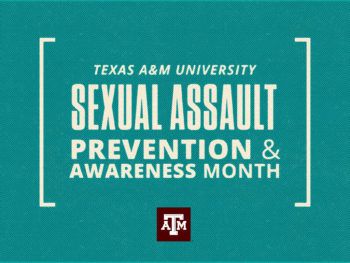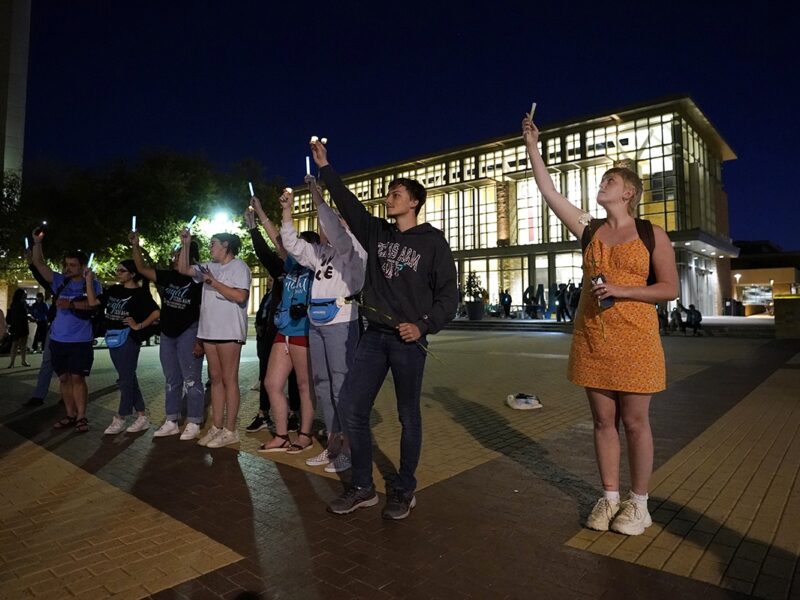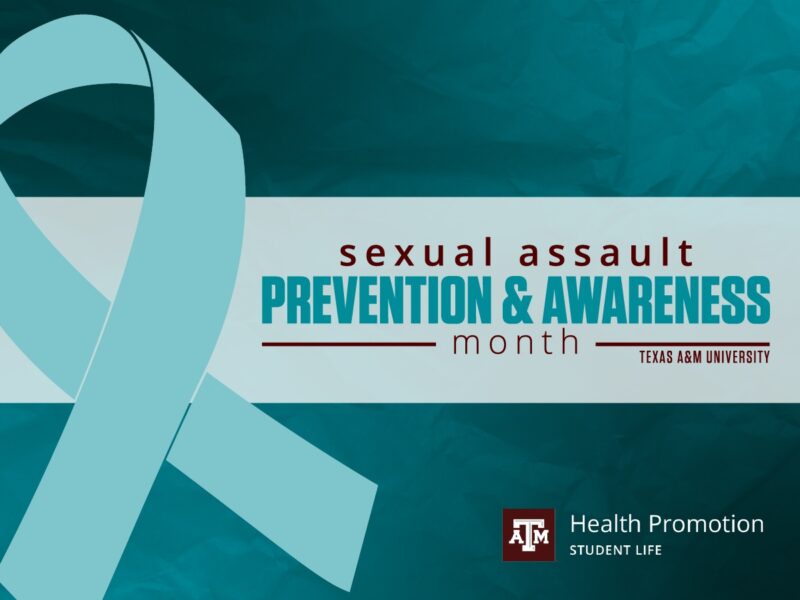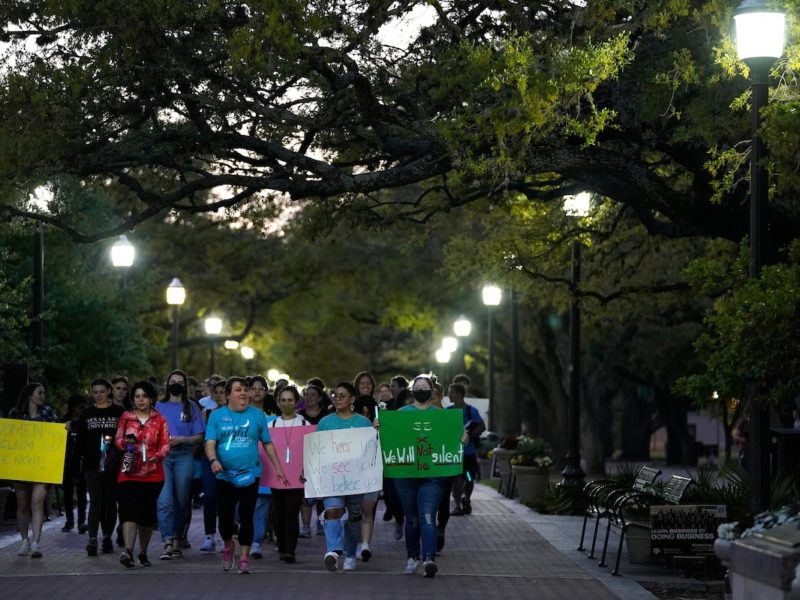‘Everybody’s Movement’: Experts Encourage All To Stand Up Against Sexual Violence

When thousands of incoming Texas A&M University freshmen attend Fish Camp to learn about Aggie traditions, they’re also introduced to the resources offered by Health Promotion. For many freshmen, says Health Promotion Coordinator Denise Crisafi, it’s the first time they’ve been in a space where sexual violence prevention is talked about openly.
In addition to the team-building exercises, intramural sports and small group discussions held at the multi-day camp each summer near Palestine, students learn about healthy relationships, bystander intervention and alcohol-related injury and illness. These conversations can be jarring for students who aren’t used to discussing these stigmatized issues, Crisafi said. But it’s a necessary discussion to have before fall classes begin: more than 50 percent of college sexual assaults happen during the first six weeks of the semester.
Through Fish Camp and Hullabaloo U – the university’s first-year experience course for freshmen – Health Promotion has a presence with students from the start of their college career. Crisafi said it’s an important step toward normalizing conversations around sexual assault and educating Aggies about the resources available to them both on campus and in the Bryan-College Station community.
“This is obviously an issue that is uncomfortable to talk about, and I wish it didn’t happen at the rates that it does,” Crisafi said. “But the only way we’re going to see that change is if we’re willing to engage in some part, whether it’s openly or more privately. We have to do something to spread this information and not be oblivious to it.”
Throughout the month of April, Health Promotion and other organizations will host a variety of events in recognition of Sexual Assault Prevention & Awareness Month. Crisafi said the goal is to spread awareness about sexual violence and how it impacts different communities. Statistically, it’s an issue that will affect many throughout their lifetime.
By The Numbers
According to the Centers for Disease Control and Prevention, more than one in three women experience sexual violence during their lifetime. For men, that number is nearly one in four.
At the Sexual Assault Resource Center (SARC) in Bryan, the organization offers crisis intervention, counseling and other services to clients ages 13 and older. In 2021, 48 percent of its clients were under 21, said Executive Director Lindsey LeBlanc.
SARC frequently presents to groups on campus about healthy and unhealthy relationships, consent, boundaries and other topics. The organization supports survivors of sexual violence through its crisis and intervention services and functions as an “end-to-end” solution during their healing journey, LeBlanc said.
Despite what many believe, LeBlanc said, it’s important to note that at the community level, only 20 percent of assaults are committed by strangers. The other 80 percent of the time, assaults are committed by someone who the survivor knows, like a friend, family member or intimate partner.
“Historically, it’s thought of as a stranger pulling into you in an alley, when those really are very rare compared to sexual violence in intimate partnership, like when a partner has had too much to drink and isn’t able to consent,” LeBlanc said. “Those ways in which we communicate boundaries have been drastically changing over the last few years.”
Relationship violence is something many young adults have experienced before they ever step on campus, Crisafi said.
In 2019, two-thirds of students polled at the New Student Conference orientation program said they or someone they know had experienced relationship violence, she said.
“They weren’t even enrolled in classes yet, so we know that they’re walking in with these experiences. Some of it might be through things like bullying or teen dating violence, but it also might be things like domestic violence, hazing in high school or child abuse,” Crisafi said.
Starting Conversations
With these statistics in mind, the experts say, it’s important to educate students about prevention strategies and available resources.
For Crisafi, she says it’s important to start by giving students a firm foundation of knowledge about healthy relationships. It’s something Health Promotion focuses on during presentations with freshmen because when they can recognize the difference between healthy and unhealthy behaviors, their confidence in how to handle situations is enhanced.
“It gives us leverage to say, ‘Let’s talk about why consent is part of a healthy relationship. What does it look like when it’s practiced in a healthy way versus in an unhealthy or abusive way?'” Crisafi said.
Consent and boundaries are also a large part of SARC’s prevention and awareness work. LeBlanc said this includes understanding boundaries and being able to discuss them with partners.
“That means if you’re in an intimate relationship those boundaries are clear up front and they are explicitly stated so everyone’s on the same page,” LeBlanc said. “That is where a lot of prevention services have to focus. What we knew about consent 20 years ago is rapidly changing, and we are clarifying those boundaries and conversations within the community.”
Health Promotion, which is located within the Offices of the Dean of Student Life, provides several trainings and programs related to reducing and eliminating sexual harassment and sexual assault, along with its programming for students on various wellness topics. Crisafi said Health Promotion works closely with Texas A&M’s Title IX office, which also provides educating and training.
Bystander intervention is a key component of the trainings available for prevention of sexual assault.
For example, Green Dot teaches the campus community how to recognize potential violence and intervene appropriately. Adopted in 2010 from curriculum originally built at the University of Kentucky, Crisafi said the program’s name is a metaphor. Incidents of power-based personal violence are like “red dots” covering the campus. “Green dots” are proactive and reactive actions people can take to prevent or intervene in a “red dot” situation.
“It creates an environment and sends a message that power-based personal violence is something that’s not tolerated or accepted, and creates an accountability process should someone see it,” Crisafi said.
When it comes to harm reduction, Crisafi said she prefers an approach focused more on bystander intervention and less on putting the responsibility on the person who was harmed.
“There are some good cautionary notes, like if you suspect your drink has been manipulated, order another one. But it’s still not your fault that someone did that,” she said. “The biggest bystander intervention tool I can give people is if you see someone who’s doing harm, it’s OK for you to have a conversation with that person, whether it’s about crossing peoples’ boundaries or predatory behavior.”
Also available to students is the STAND Up Trauma-Informed Care training, which teaches individuals how to have conversations with those who have been involved in a traumatic event related to power-based personal violence.
“There are also other organizations in our community that reach where we can’t,” Crisafi said, including SARC, Scotty’s House, Twin City Mission Domestic Violence Services and Unbound. “They can provide education and help students process trauma in the same place, and they don’t have an obligation to report. I think it’s really important for our students to know it’s there for them.”
Crisafi encourages students, faculty, staff and members of the community to attend the events on campus throughout Sexual Assault Prevention & Awareness month to learn more about what they can do to help combat the problem.
“This is everybody’s movement,” Crisafi said. “It’s not something that happens to just some people. This belongs to everyone, regardless of their identity.”
Media contact: Caitlin Clark, caitlinclark@tamu.edu





